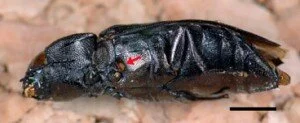 The larvae of the pine beetle Melanophila acuminata can only develop by eating wood inside freshly burned trees. In order to provide for their hungry offspring, the Melanophila beetle, known as the black fire beetle, developed an interesting trait. They possess a small external organ (indicated by the arrow in the picture here) that detects infrared heat radiation (such as would be produced in a forest fire) from great distances. Continue reading
The larvae of the pine beetle Melanophila acuminata can only develop by eating wood inside freshly burned trees. In order to provide for their hungry offspring, the Melanophila beetle, known as the black fire beetle, developed an interesting trait. They possess a small external organ (indicated by the arrow in the picture here) that detects infrared heat radiation (such as would be produced in a forest fire) from great distances. Continue reading
Could Conjoined Twins Share a Mind?
 Krista and Tatiana Hogan are craniopagus conjoined twins — joined at the head, they share a neural bridge.
Krista and Tatiana Hogan are craniopagus conjoined twins — joined at the head, they share a neural bridge.
It was bedtime for Krista and Tatiana Hogan, and the 4-year-old twin girls were doing what 4-year-olds everywhere do at bedtime. They were stalling, angling for more time awake. Their grandmother, Louise McKay, who lives with the girls and their parents in Vernon, a small city in British Columbia, was speaking to them in soothing tones, but the girls resorted to sleep-deferring classics of the toddler repertory. “I want one more hug!” Krista said to their grandmother, and then a few minutes later, they both called out to her, in unison, “I miss you!” Continue reading
T Cells ‘Hunt’ Parasites Like Animal Predators Seek Prey, a New Study Reveals
 By pairing an intimate knowledge of immune-system function with a deep understanding of statistical physics, a cross-disciplinary team at the University of Pennsylvania has arrived at a surprising finding: T cells use a movement strategy to track down parasites that is similar to strategies that predators such as monkeys, sharks and blue-fin tuna use to hunt their prey.
By pairing an intimate knowledge of immune-system function with a deep understanding of statistical physics, a cross-disciplinary team at the University of Pennsylvania has arrived at a surprising finding: T cells use a movement strategy to track down parasites that is similar to strategies that predators such as monkeys, sharks and blue-fin tuna use to hunt their prey.
With this new insight into immune-cell movement patterns, scientists will be able to create more accurate models of immune-system function, which may, in turn, inform novel approaches to combat diseases from cancer to HIV/AIDS to arthritis. Continue reading